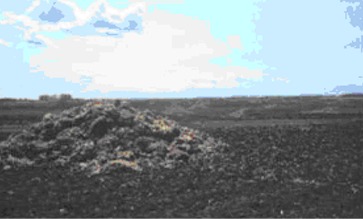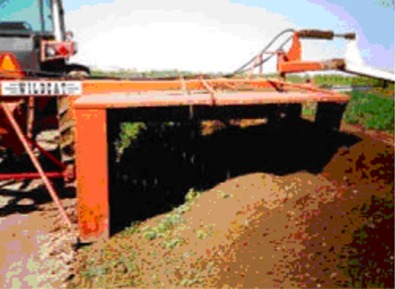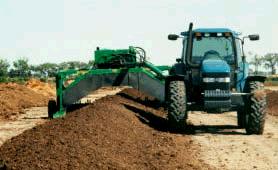| | February 2001
What is Composting?
Composting is the natural biological breakdown of organic material into a more stable organic substance. During the process of aerobic composting (presence of oxygen), microorganisms consume organic matter (carbon) and release heat and carbon dioxide (CO2 ). Aerobic composting methods decompose material faster and more efficiently than anaerobic composting methods (absence of oxygen), such as stock piling manure (Fig. 1). Persistent odours and the risk of water contamination by surface runoff are reduced when agriculture wastes are composted compared to conventional land management (stock piling manure). Further, composting is a waste management system that createsa recycled product, which is carbon rich and free of most pathogens and weed seeds.
How Do Nutrients Affect the Composting Process?
Microorganisms involved in composting require a “balanced diet” to operate efficiently. Carbon, nitrogen, phosphorus and potassium are the primary nutrients required by microorganisms. The most important nutrient balance in compost is the carbon to nitrogen ratio (C:N); the optimum is approximately 25:1. This C:N ratio ensures that other nutrients are present in adequate amounts (Table 1). In comparison, soil C:N ratio is 10:1. When compost has a C:N ratio less than 25 it is considered mature (CCME 1996).
Table 1: Initial characteristics of various
composting materials |
| Compost Material | C:N Ratio Class* | Moisture Class** | Compost Rating |
 |  |  |  |
| Cattle manure | Low | High | Good |
| Poultry manure | Low | Moderate | Good |
| Horse manure | High | Low | Excellent |
| Swine manure | Low | High | Fair to good |
| Crop residues | Moderate | Moderate | Excellent |
| Spoiled hay and silage | Moderate | Varies | Fair |
| Straw, sawdust, leaves | High | Low | Good |
| Grass clippings | Low | Moderate | Good |
| Slaughterhouse wastes | Low | High | Fair |
* Low C:N<10; moderate C:N is between 10 and 50; high C:N>50
** Low moisture <20%; moderate moisture is between 40 and 60%
Source: Rynk 1992 |

Figure 1: Stockpile of bedding material
What are the Optimum Environmental Conditions of Composting?
Temperature, moisture and oxygen availability must be adequate for microorganisms to thrive. Compost pile temperatures between 43°C and 66°C are optimum for composting, and desirable to destroy pathogens, weed seeds and fly larvae. Moisture content between 40 and 65 percent is optimum. Below 40 percent, microbial activity slows, while above 65 percent, water displaces air-filled pore spaces and limits aeration. Aerobic conditions for the composting process require oxygen concentrations above 10 percent.
What Materials Can be Composted?
Generally, organic materials such as manure, crop residues or animal mortalities, are composted. Other materials called ‘bulking agents’ are sometimes added to provide structure, allow air to circulate more freely, and increase carbon content. Wood chips, straw or leaves are examples of bulking agents.
For some producers, these organic materials are generated in large volumes making disposal a challenge. If not disposed of properly, animal manure can cause nitrate contamination of groundwater and nuisance odours for nearby residents. Animal mortalities may also carry pathogens that can contaminate other stock. With the expansion of the livestock sector in Alberta, it is important to address the issues of agricultural waste disposal.
What are the Different Composting Methods?
There are four general groups of composting methods used on farms: passive, windrows, aerated piles, and in-vessel composting. Each method changes the composting process by changing aeration, temperature and/or material movement, and requires a different investment of time, equipment and land.
Passive composting
Passive composting involves piling organic materials to decompose with minimal turning and management. Generally, this method is used for materials that have high porosity, such as leaves, because oxygen supply is dependent on passive diffusion. Passive composting piles still need to be turned periodically to increase aeration and rebuild porosity. This composting process is slow, taking months to years to mature, and is more likely to produce odours, because of its low aeration rate.
Machine-turned windrow composting
Machine-turned windrow composting consists of placing organic materials in long narrow piles or windrows, which are agitated or turned ona regular basis. Turning the compost pile increases porosity, releases trapped heat, water vapor and gases. The size and shape ofa windrow depends on the type of machine used to turn the material and the characteristics of the material. Light and porous compost materials can be built into larger windrows than materials that are dense with high moisture content. During the winter, windrows can be made larger to increase insulation and reduce heat loss.
Aerated windrow or pile composting
Aerated composting systems can be aerated either passively or actively. Passively-aerated composting eliminates the need for turning by supplying air to the composting materials through perforated pipes or layers of porous material embedded in each windrow. Open-ended perforated pipes are placed at the base of a compost pile. Compost material is then loaded on top of the pipes, and airflow is achieved through convection. The pipes are pulled out once composting is completed. Actively-aerated composting uses a fan to supply air to the compost material through the pipes. Theoretically, no turning of the materials is required; however occasional turning breaks up air channels, redistributes moisture, and exposes fresh material to microbial attack. The advantage of aerated composting systems is it takes much less time to compost than passive systems.
In-vessel composting
In-vessel composting involves the confinement of compost materials in a building, container or vessel. Although there are different in-vessel composting methods, most rely on a variety of forced aeration and mechanical turning techniques to speed up the composting process. It is the fastest and most costly composting method but requires the least area and involves the greatest level of control over the composting process.
What are the Greenhouse Gas Emissions from Composting?
Carbon dioxide (CO2 ), methane (CH4) and nitrous oxide (N2O) are all by-products of the composting process. These three greenhouse gases (GHG) contribute to global warming by absorbing radiation emitted by the earth. The ability of each GHG to trap heat depends on its capacity to absorb and re-emit radiation and on how long the gas remains in the atmosphere. This is referred to as the global warming potential (GWP). To compare GHG emissions of different gases the GWP is multiplied by the amounts of each gas emitted to get units of CO2 equivalents (CO2e) (Table 2).
Table 2: Greenhouse gas global warming potentials (GWP) over 100 years |
Greenhouse Gas | Global Warming Potential
(GWP) |
Nitrous Oxide | 310 |
Methane | 21 |
Carbon Dioxide | 1 |

Are There Environmental Benefits from Composting?
Composting represents a recycled, low input form of slow release fertilizer. Compost application to soil reduces the amount of inorganic fertilizer required. Therefore, the net GHG emission is reduced because the energy-intensive fertilizer production and associated GHG emission is reduced. In addition, compost amended soil is more resistant to wind and water erosion because soil structure is improved and soil moisture-holding capacity is increased. Adding compost to soil alleviates soil compaction by improving root penetration, water absorption and drainage.
Composting manure reduces the weight and volume of raw manure, allowing it to be hauled longer distances. Specially designed composts can help break down contaminants in water or soil after industrial accidents. The life of landfills can be extended by diverting organic wastes into a waste treatment process (composting), which sanitizes wastes into a new high quality product.
Summary
Composting is an alternative to conventional management of agricultural wastes. It producesa recycled product, which is carbon rich, free of most pathogens and weed seeds, and enhances soil quality. Studies suggest that aerobic composting systems emit less total GHG (CO2e) than anaerobic composting systems. However, further research is needed to quantify the amount of GHG emitted from the composting process.
.
To order more copies of this bulletin, contact Agri-Environmental Management Branch, Alberta Agriculture and Rural Development at (780) 422-4385
Sources:
1. Canadian Council of Ministers of the Environment (CCME). 2006. Guidelines for compost quality. Composting Subcommittee, Solid Waste Management Task Group, Canadian Council of Ministers of the Environment, CCME-106E, p11.
2. Hao, X., Chang, C, Larney, F., and Travis, G. 2000. Greenhouse gas emissions during cattle feedlot manure composting. In 37 Annual Alberta Soil Science Workshop Proceedings. February 22-24, 2000, Medicine Hat, Alberta, pp28-34.
3. Rynk, R. F. 1992. On-farm composting handbook. NRAES-54. Ithaca, NY: Northeast Regional Agricultural Engineering Service.
4. Watson, R. T., Zinyowera, M.C., Moss, R. H. and Intergovernmental Panel on Climate Change. 1996. Climate change 1995 impacts, adaptations and mitigation of climate change: scientific-technical analyses: contribution of WGII to the second assessment report of the Intergovernmental Panel on Climate Change. New York: Cambridge University Press.
Acknowledgements
In addition to AAFRD staff, we would gratefully like to acknowledge the following external reviewers: Dr. Jerry Leonard from the University of Alberta; Alfredo Carcamo from Olds College; and Dr. Frank Larney from Agriculture and Agri-Food Canada. |
|